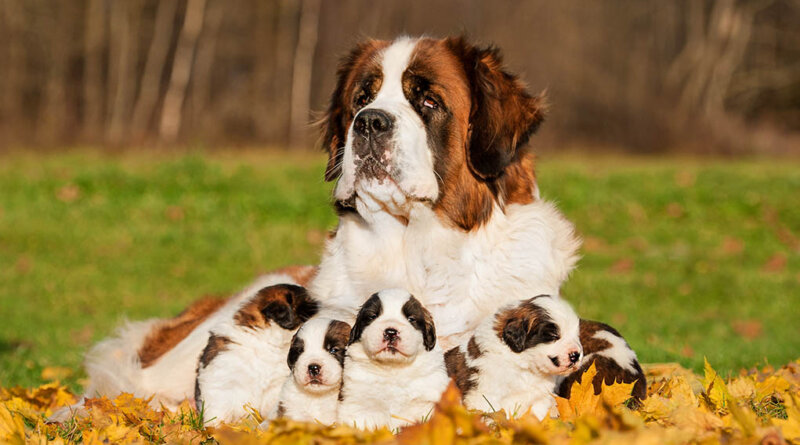Saint Bernard Dog Breed Profile – Top Dog Tips
The Saint Bernard dog breed giants may seem intimidating but they are full of warmth and affection. Saint Bernards are the sweetest and warmest companions.
They are the type to subtly show they don’t mind the attention but when you give it to them, they welcome it with open paws.
In addition, if you’re planning to adopt a Saint Bernard puppy, make sure to adopt through a reputable breeder. Research thoroughly the best breeders in your area.
A responsible breeder can show you the health records of the dog’s parents and even essential shots. On the other hand, you can also look for rescue groups like the Saint Bernard Rescue Foundation, Inc.
However, Saint Bernards may not be the best for new owners. If you’re up for the challenge to match their stubborn intelligence and high maintenance need, then they may be a good option for you.
You can check out this FULL dog breed profile or consult with a veterinarian about Saint Bernards further if you want to adopt one.
History of the Saint Bernard Dog Breed
In the snowy summits, these mighty dogs have conquered the cold-biting mountains of the Alps. Now, Saint Bernards are conquering our hearts with their giant but gentle affections.
These heroic giants have been found in a hospice established by a monk named Bernard Menthon. These absolute units worked as search and rescue dogs to aid travelers who passed by the extremely snow-white passage of the Alps.
In the 17 century, Saint Bernards are known to be search and rescue dogs in the Swiss Alps. With their ability to search through scents and their extraordinary strength, they can help adrift travelers in the snow.
Soon, Saint Bernards become working dogs in valleys and farms. They herd cattle, guard corps, and draft with farmers as well.
It is said that the original traits of Saint Bernard were reduced over time because of the dangers of avalanches and severe weather.
In that account outcrossing Saint Bernard to longer-haired dogs, like the Newfoundland, became a solution to address the event. Now Saint Bernards have variations of short-haired to long-haired coats.
Saint Bernard’s extraordinary sense of smell can help them detect their targets even when it is buried beneath the ground.
Their huge paws help them dig down the ground. These features helped them build a reputation for the perfect working dogs.
Saint Bernards can have six to eight litters but in rare instances, they can have more than 8 litters.
What are Saint Bernard dogs like? Let’s take a look at some features to get you started.
Physical Characteristics of a St. Bernard
Their feet are wide and webbed for a more efficient take on water activities.
Keep in mind that Saint Bernard has a low tolerance for warm weather. It’s best to adopt this breed when you reside in colder areas. A Saint Bernard’s body can easily overheat.
Have them stay in a cool area or give them activities such as a swim in the pool or maybe even an ice bath now and then.
Height and Weight
When it comes to the Saint Bernard dog breed height, male Saint Bernards stand about 28 to 30 inches at the shoulder while females are 26 to 28 inches.
On the other hand, male Saint Bernards’ average weight is 140 to 180 pounds while females are at 120 to 140 pounds.
Temperament of Saint Bernards
Saint Bernards are quintessential family dogs. They are extremely great around their family. Despite their large stature, these giants love to cuddle, they might be too big for a lap dog but they want that spot anyways.
They also do amazing with children. They are marvelously patient with children but that doesn’t mean you can leave them alone with children. Their large stature and cuddly personality may be too heavy for children. They may accidentally knock a few antiques now because of their size, but we’d still love them.
Saint Bernards are sensitive in terms of detecting emotions and danger. They may not be as welcoming to strangers as they are to their families. Owners should introduce strangers to them carefully. They may assess if the stranger is a possible threat. If the owner feels and displays safe and comfort around the stranger, Saint Bernards will welcome the alien visitor.
Saint Bernards may have trouble around other dogs. They are vigilant of other dogs. They may become aggressive, especially around unfamiliar dogs but if socially exposed and trained young not to react to strange dogs, they will be able to interact without charging other dogs.
Saint Bernards are an extremely vigilant breed. This breed was made to be working dogs with alert personalities. That’s why they do well in adapting to their surrounding.
Living with a Saint Bernard
Saint Bernards are noticeably large and they need large space requirements. They need a home with a large space for them to move around even when it’s not playtime.
Saint Bernards are to be kept indoors unless going out for training, exercise, or outdoor activities. They may become destructive and mischievous when left alone outside.
Saint Bernards have a significant instinct to search and rescue people. It’s best to appease this urge with activities that are virtually and physically like search or rescue activities.
Saint Bernards rarely bark unless they are excited or they sense danger.
With the way their lower jaw is shaped and the loose skin, they have a great tendency to drool a lot.
Health Care & Diet of St. Bernards
The Saint Bernard dog breed is generally a healthy dog. But just like all dog breeds, they are still prone to certain health problems.
Allergies
Allergies are one of the most common ailments in not just Saint Bernards, but dogs in general. There are food allergies, contact allergies, and inhalant allergies.
Food Allergy
To identify and treat a certain food allergy, the owner should eliminate certain foods from the dog’s diet until the food-causing allergy is discovered.
Contact Allergy
Contact allergies are triggered when something touches their skin. For instance, it can be from bedding, flea, powders, dog shampoos, or any other chemicals.
Inhalant Allergy
Inhalant allergy is caused by airborne allergens. It can come from pollens, dust, and mildews.
Treatment, however, will depend on the severity of the allergy. In some cases, ear infections are side effects of inhalant allergies.
Dilated Cardiomyopathy/ Cardiac Disease
Dilated Cardiomyopathy is a gradual escalating loss of function and abnormalities of the heart. Due to heart muscles dilating and thinning of walls, heart failure is possible. Dogs with this condition often have fluid build-up in the lungs can cause difficulty in breathing. Over time, the fluid buildup may become fatal for the dog.
Cataracts
A cataract is an obstruction of lens fiber in the lens of an eye. the gradual clouding of the lens in the eyes. Although this is more common in elderly dogs it can also be acquired through genetics, traumatic injuries in the eyes, nutritional deficiencies, or diabetes.
Have your pet undergo an ophthalmic examination to detect small cataracts as early as they age four to five. To determine whether it is blinding or not, it is better to check with your veterinarian to be informed what procedure should be done.
Options for prevention of this disease are very small as well, proper diet and refraining from exposure to toxins may lessen the risk for cataracts.
Elbow Dysplasia
Another health condition that Saint Bernards are prone to be Elbow Dysplasia. Elbow Dysplasia is a heritable condition that is common to large breed dogs.
Other causes of this disease can be the growth rate, high-protein diet, trauma, hormonal imbalances, poor nutrition, and rapid weight gain. Dogs may experience painful lameness when this happens.
Your vet may recommend surgery as the treatment to correct the problem. Ask them about medications to control the pain and proper weight management.
On the other hand, this is a genetic developmental disease. It all comes back to adopting from a reputable breeder to make sure that you’re getting a healthy pup.
Entropion
Entropion is a defect that can be seen as early as six months of age. This health problem causes the eyelid to roll inward, it’ll irritate or injure the eyeball.
Monitor your dog if he is rubbing his eyes because both eyes can be affected by this condition. Fortunately, Entropion can be corrected through surgery.
Epilepsy
Epilepsy in dogs is a disorder that can cause mild to severe seizures. Just like Elbow Dysplasia above, Epilepsy can also be a hereditary condition.
Epilepsy can be triggered by metabolic disorders, infections diseases that impact the brain, tumors, vulnerability to poisons, or head injuries.
Monitor your dog, if you notice that they are exhibiting unusual behavior like running frantically, staggering, or hiding, it can be an indication that they are having a seizure.
Epilepsy can be controlled with proper medication, however, it can’t be cured. Fortunately, dogs can still live a long and happy life with the right medication and proper management of this disorder.
If you’re Saint Bernard is having a seizure, rush him to the vet for a diagnosis and treatment.
Gastric Dilation Volvulus (GDV – Bloat)
Gastric Torsion or Bloat is a gastrointestinal condition where-in a dog’s stomach expands due to it teeming with fluid, food, or gas. This can be a fatal circumstance if left untreated. In some cases due to bloating, blood is trapped in the stomach preventing return and proper flow.
Prevention includes avoiding your dog to do activities right after a meal, eating meals too fast, large meals throughout the day, and stressing them. Treatment may depend on your veterinarian’s observation.
Hip Dysplasia
Hip dysplasia is a genetic condition wherein the socket of the joint and ball becomes distorted. Newfoundlands are prone to Hip Dysplasia. Due to their large stature, their mass stresses their lower body areas, especially in their joints.
When diagnosed with hip dysplasia, it’s important to keep their weight in the normal range and have them exercise with activities that promote joint therapy. Veterinarians may prescribe medications for anti-inflammatory/ pain relievers and supplements.
Prevention is the same, keeping them active but not injuring them as well. A treadmill walk or swimming is perfect for prevention and recovery as well.
Exercise and Training
When it comes to exercise, the Saint Bernard dog breed only needs moderate amounts. However, exercise is crucial for these dogs to avoid obesity.
Obesity is a big no-no to Saint Bernards (well, to every dog breed too) because too much weight can lead to joint problems like arthritis or orthopedic problems.
On the other hand, make sure to limit their exercise routines when they are still puppies. Wait for them to reach their mature size.
Furthermore, it’s best to start their training when they are still young.
Remember, these giants are intelligent as well but they may become difficult at times. Training them at a young age may help train their obedience. Keep in mind to keep the training exciting for them as well.
Early training is essential to avoid them to grow up as naughty or mischievous dogs. Be relaxed and happy when training them. Positive reinforcement is the main key.
Commonly Asked Questions about a Saint Bernard
Which is better male or female St. Bernard?
Are you torn between adopting a male or a female Saint Bernard? Well, let me tell you, besides their size difference, there is no difference between them.
They are both trainable and affectionate. Just make sure to neuter them at a young age to reduce the chances of major illnesses.
Are St Bernards cuddly?
Saint Bernards are cuddly as a teddy bear. But at the same time, they are the size of a real bear.
They love everyone they meet. They are not needy of attention, but instead, they prefer to give this attention to their family or owner.
How Much Does A Saint Bernard Cost?
If you’re planning to adopt a dog, or a Saint Bernard to be exact, don’t expect it to be cheap. The cheapest option would be adopting from adoption facilities. Their cost goes from $50 to $300.
If you’re eyeing the breeder route, Saint Bernards will cost around $600 to $2000. Most good quality Saint Bernards cost around $1000. It is suspicious to find a Saint Bernard that is $500 or below.
But you can always look at Rescue Groups like the Colorado St. Bernard Rescue or the Saint Bernard Club of America.
Saint Bernard Dog Breed Profile Summary
If you’re looking for a big and loveable dog to adopt, the Saint Bernard dog breed might be the perfect match for you.
Saint Bernards are the type of dogs that doesn’t need attention, but instead, they love to give love and affection.
Despite their large size, this dog breed is a great family dog. Since they are patient dogs, they do well with children.
Saint Bernards are also good at adapting to their environment. They were originally working dogs with alert personalities, that’s why they are extremely vigilant dogs.
If you love cuddly and big teddy bear dogs, you can’t go wrong with having a Saint Bernard puppy in your life.
READ NEXT: DALMATIAN DOG BREED PROFILE
Related











Some are medicines that help people when doctors prescribe. Generic Name.
https://canadianfast.com/
Get here. Drugs information sheet.
Learn about the side effects, dosages, and interactions. Everything about medicine.
https://canadianfast.com/
drug information and news for professionals and consumers. Read now.
pharmacy prices compare https://pillswithoutprescription.pro/#
dark markets 2023 the dark internet
[url=https://flagyl.gives/]flagyl generic cost[/url]
blackweb dark websites